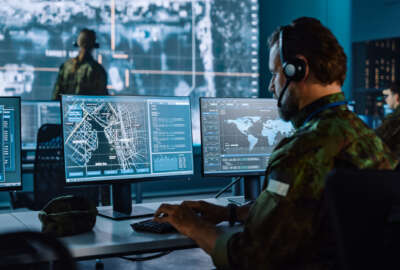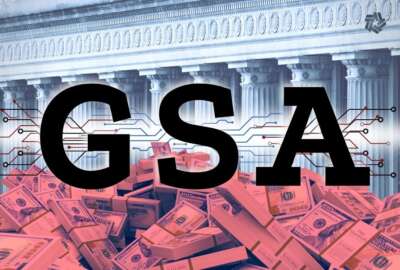Using data, revolutionary Sammies finalist sees forest for the trees
Robert McGaughey revolutionized the U.S. Forest Service’s ability to visualize aerial surveillance data as useful information.
With too much data, you can lose sight of the forest for the trees. The Federal Drive with Tom Temin spoke to a guest who revolutionized the ability of the U.S. Forest Service to visualize, as useful information, the mass of data from aerial surveillance. For his work, he’s a finalist in this year’s Service to America Medals program: Research Forester Robert McGaughey.
Interview Transcript:
Tom Temin With too much data, you can lose sight of the forest for the trees. Well, my next guest revolutionized the ability of the U.S. Forest Service to visualize, as useful information, the mass of data from aerial surveillance. For his work, he’s a finalist in this year’s Service to America Medals program. Research forester Robert McGaughey joins me now. Mr. McGaughey, good to have you with us.
Robert McGaughey Thank you, Tom. Nice to be here.
Tom Temin And you are a programmer of software code that did something to other software to make it usable. Tell us what you’ve done here.
Robert McGaughey So, technically, I’m trained as a forester, so it’s an interesting combination being a programmer and a forester. But the technology that I work with is called airborne lidar. That’s light detection and ranging. And the basic idea is you have this laser rangefinder in an aircraft that fires out millions of pulses per second, or a million pulses per second. It gets a measurement of every object that that pulse hits and naturally produces a lot of data. So the software that I developed reduces that data down to more usable products. The software has been around for about 20 years and been used across the country within federal agencies, universities especially, and then around the world as well.
Tom Temin Interesting. So the lidar is then surveillance that is not photography. It’s surveillance using this lidar. And what is the output of lidar in its raw form?
Robert McGaughey The true raw form are just range measurements from an aircraft. So the distance to an object that’s hit by that laser pulse, that’s combined with the position and attitude of the aircraft to get an actual XYZ point for every object that’s hit. And as I said, it’s millions of points over a small area, densities in the ten points per square meter and higher.
Tom Temin So, in other words, it’s a way of representing as data a three-dimensional, potentially three-dimensional image of what you’re looking down at with the lidar equipment.
Robert McGaughey Exactly, exactly. That’s it.
Tom Temin And so the output of putting the lidar data through your program, does that result in pictures or visualizations?
Robert McGaughey Visualization is a big part of it. Just understanding what these systems measure. It’s kind of hard to wrap our brains around the complexity that happens, you know, with this laser and the distance and the precise attitude and everything, but just knowing that it hits trees, buildings, the ground especially is important. But we reduce that down to something that’s more usable, just a whole bunch of points. It’s interesting to look at, but from an information standpoint, you know, our brain processes things really well, and we can see patterns and see objects that we recognize. But getting our computer to see that is a little different.
Tom Temin So how does this work in a practical sense for the Forest Service? First of all, we’ll talk about that context that you developed it for in the first place.
Robert McGaughey So, for us, it was really a research problem to start with, to understand that these systems were even useful for forestry. We knew that they could measure the ground really well, very accurately, but we didn’t even know if we would get data from trees. So once we realized that we could get good measurements from trees, we could measure the tree height over very large areas. We can measure variability in that height. We can measure patterns of vegetation. So there are trees in some areas, not trees in others. You know, big trees, little trees. And all that information is useful for making management decisions. It starts to give us information about the size of the trees, potential value, something about the age just because of their size, where there are denser areas of trees that might need to be thinned to encourage growth, or to remove or reduce fuel for fire risk. Things where we might want to go in and plant because there’s not enough trees. So all those kind of things are useful information to have over the large areas, and it’s wall to wall over the areas covered by this data.
Tom Temin I suppose it could also tell you reasons to look into further as to why the forest density is higher here, as opposed to there also.
Robert McGaughey It could give you some indication. At least it would tell you the areas where you have conditions that maybe you want to know more about. So kind of a reconnaissance before you were to go to the field to do more work.
Tom Temin We’re speaking with Robert McGaughey. He’s a research forester with the U.S. Forest Service and a finalist in this year’s Service to America Medals program. Okay, so we understand what’s happening here from the forestry standpoint for our programing listeners. Then what did you do to convert the point data from the lidar into these visualizations or information that’s usable?
Robert McGaughey So, this software, which is called Fusion, because it fuses different sources of data to help you understand what they all measure. As I said, there is a visualization component that just lets you grab small samples of these data and spin them around and look at these point clouds. Really useful for just understanding what’s being measured. But probably most useful, there’s a whole suite of programing tools or smaller components that allow you to string together commands to take this point cloud and reduce it down to information in a raster form. So that’s like little cells of information that have been summarized from the point data. Much smaller, much easier to work with. Typically, in a geographic information system, that data becomes very useful and very digestible to other types of software. So the software that I’ve developed really takes that raw XYZ point cloud or three-dimensional point cloud, and boils that down into something that’s much more usable for a broader audience.
Tom Temin Well, how did people use lidar data before this?
Robert McGaughey I started developing software pretty much about the same time lidar came to forestry. So in the late 90s, there were some initial research efforts to understand what the technology could do. I like to joke our first project included 40 million data points and we had no software. There was nothing commercially available that really could handle 40 million points. Today, that’s collected in a blink of an eye. I mean, literally, we collect 40 million points in a few seconds.
Tom Temin Right. When the first hard drives came out for PCs in that era, you had to decide, should I get the five megabyte drive or the ten megabyte drive?
Robert McGaughey Yes. Things have come a long way. Yeah, we just keep adding zeros to the end of those numbers, and we seem to add them pretty quickly.
Tom Temin And as a forester, I mean, you were trained as a forester. That was your career choice. How did you bridge from looking at trees as a forester to looking at trees as a programmer?
Robert McGaughey So, my undergraduate work was in forestry and I did a masters in forestry, but I developed software for my master’s work as well. My original work was in timber harvesting. It was in doing the engineering design behind some of the systems used out West. It’s one of those things, you know, computer programing, take a couple classes. I had an aptitude for it and I actually really enjoyed it. I always see it as kind of the ultimate engineering thing, where you’re building something that accomplishes a task. So a lot of self-taught. The software that I developed is developed in C++.
Tom Temin Yeah, that was my question. Because when you started, I mean, people were still programming point and coordinate data using Fortran and languages in that era.
Robert McGaughey Yes, that’s true. That’s true. I actually did some Fortran work at one point, but pretty much self-taught on C and C++. Having probably advanced as far as I, you know, could have in that realm. But my software works. It’s very robust. I’ve had the good fortune of having a partnership with a group in the Forest Service that develops training materials, and so we get a lot of testing and training done through the support from that group as well.
Tom Temin Sure. And now Fusion is in the open source world. How else have people applied it that you’re aware of?
Robert McGaughey So, open source is a sticky word today because it implies certain things. It’s freely available software. It’s not really developed as an open source project where we have multiple contributors, but it’s been picked up. The software is distributed as executables, the code is available, but it’s been picked up in academia to a large extent and used to help teach students what you can do with wider data. And I see that as one of the most valuable things. It’s just we’ve had a whole set of students go through academia that now know about lidar and how to apply it to natural resource things. It’s used internationally. If you do a survey of the literature you’d find, I would say, maybe one in four papers have used the Fusion software to do some of the point cloud processing, partly because it’s free, so people can download it and use it, and it really is designed from a forestry perspective rather than a remote sensing or engineering perspective. So, some of the products, in the way that it does things and kind of the terminology and everything are friendly to foresters. So that’s really helped it be picked up and used around the world.
Tom Temin And are you still working on it? Do you still work to perfect it?
Robert McGaughey I am still working on it, yes. There’s actually a release that’ll come out here in the next week or two that incorporates a new point cloud format for the data, probably do two to three updates a year or major updates. I haven’t really added a lot of new capability for a few years, but we continue to kind of work on how to chew through lots of data faster. These data sets, as I said, are huge. Billions of points, literally, consuming pretty large space on disk drives and that kind of thing. So there’s a real focus now on moving things into the cloud and processing that way.
Tom Temin You’ve moved from the Fortran world to the Drupal and Kubernetes world of large data sets in the cloud.
Robert McGaughey At least as far as large data sets. The software doesn’t really deal with things in the cloud. It’s really set up for desktop use, and it’s all Windows-based, partly because that’s what the Forest Service uses for its computing system. So it’s always been developed to run on the systems that we have available to us.
Tom Temin Sure. And you are a forester, ultimately. Do you still get out and hug a tree once in a while and not just a keyboard?
Robert McGaughey I do. Not as much as I would like to sometimes, but I do still get to go out. We do a lot of field work. I’m also an affiliate instructor at the University of Washington back in Seattle, and I get to work with grad students who have just super interesting ideas and projects that they’re working on. So a lot of that is where the field stuff comes in, as you know, working with small areas and working with very specific projects. A lot of the large area work is just kind of recipe-driven. You plug the data in, you chew it through the software. You get a set of layers, and then there’s some standard uses that those layers are used for.
Tom Temin Sure. So a lot of people speak for the trees, but in some sense you have enabled the trees to speak to you.
Robert McGaughey You could say that, yeah. We’ve kind of enabled an ability to capture a lot of information that would have taken people weeks, months on the ground.
Tom Temin Robert McGaughey is a research forester with the U.S. Forest Service and a finalist in this year’s Service to America Medals program. Thanks so much for joining me.
Robert McGaughey You’re welcome, Tom. This has been great.
Tom Temin And we’ll post this interview along with a link to more information at federalnewsnetwork.com/federaldrive, where you can find all of our Sammies interviews. Subscribe to the Federal Drive wherever you get your podcasts.
Copyright © 2025 Federal News Network. All rights reserved. This website is not intended for users located within the European Economic Area.
Tom Temin is host of the Federal Drive and has been providing insight on federal technology and management issues for more than 30 years.
Follow @tteminWFED






